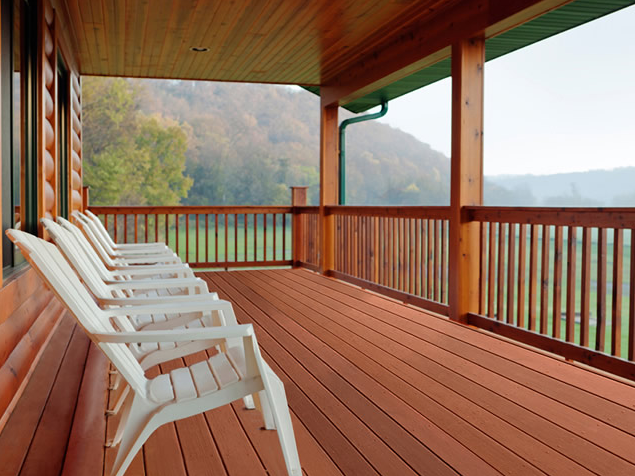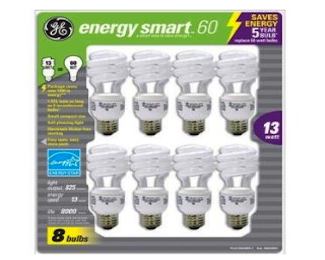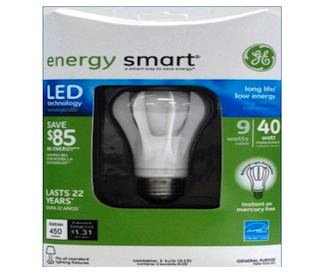Energy Efficient Light Bulbs
These products are longer a fringe item, energy efficient light bulbs like the compact fluorescent (CFL) and their newer relative the LED bulb, are now in the mainstream. Switching to more energy efficient lights is one of the quickest, easiest, and affordable ways to instantly start saving energy and money in your home.
The Environmental Benefits of Energy Efficient Light Bulbs
Whether you choose CFLs or LEDs, the energy-savings are substantial. The Energy Star program certifies that these products meet strict efficiency guidelines set up by the EPA. Less energy usage means lower utility bills, and protection for the environment by reducing greenhouse gas emissions associated with power production.
An Energy Star light bulb (ALWAYS look for the Energy Star label on light bulb packages!) is certified to save at least $6 a year. Due to their long lifespan, this can mean more than $40 over its lifetime. CFLs and LEDs use about 75% less energy than a traditional incandescent bulb and last 6 times longer. These savings more than make up for the higher initial cost of the bulb.
Energy Star has estimated that if every U.S. home replaced just one light bulb with an Energy Star rated efficient bulb, we'd save enough energy to light 3 million homes for a year, save $600 million in annual energy costs, and prevent 9 billion pounds of greenhouse gas emissions yearly, equal to about 800,000 cars!
Today's Energy Efficient Standard-Bearer: The Compact Fluorescent Bulb
CFLs have been around for a couple decades now, but have only recently started to make inroads with the general public. Initially expensive (I purchased one in 1991 for $45), costs have dropped sharply. I saw them on sale this week for $1 a bulb. While still more expensive than incandescents, the long-term energy and money savings will pay for the cost of the bulb many times over.
CFL Concerns: Light Quality and Mercury
State and federal governments are starting to enact laws that will restrict the sale of traditional incandescent bulbs over the next few years in order to take advantage of the efficiencies of newer bulb technologies. This has led to fear-mongering by some, claiming that the light quality of these newer bulbs (especially CFLs) doesn't compare to incandescent light.
To a certain extent, they are right. The light is somewhat different, but I have noticed huge improvements in the light quality of CFLs over the last few years. (We only use CFL bulbs around here.) To simulate the warm glow of an incandescent, make sure you buy a 'Soft White' CFL bulb. For offices or shops, 'Cool White' bulbs produce a brighter, whiter light.
lder CFLs typically had a slight buzz when turned on, and a subliminal flicker effect that bothered some people. New bulbs don't have these issues.
One downside to CFLs is that they contain a small amount of mercury, which is a toxic substance. The amount is small, an average of 4 mg. sealed within the tube. It would take 125 CFL bulbs to equal the mercury in one old-fashioned thermometer. The amount of mercury in bulbs has dropped by 20 percent in recent years, and continues to drop.
The mercury is perfectly safe while the bulb is intact. If a bulb breaks, it is important to carefully clean up the debris, keeping pets and kids away. Old CFL bulbs should be recycled to keep mercury out of landfills.
Since electricity production is the main cause of mercury pollution in the U.S., using energy efficient CFLs actually keeps more mercury out of the atmosphere than they contain.
New Kid on the Block: LED Bulbs
LED bulbs are just beginning to enter the mainstream, but are clearly the future of efficient lighting. LEDs are as efficient as CFLs, but are designed to last much longer (25,000 hours vs. 10,000 for CFLs)
LED bulbs contain no mercury, and can be used with dimmers. (Only special CFLs can be used with dimmers.) Just like CFLs in their early days, LEDs are quite expensive. Costs will drop and quality will rise over time.
At Green Home Source, we fully endorse the energy-efficiency of CFLs and LEDs. The energy, money, and emission savings are simply too significant to ignore.
comments powered by Disqus








































































































































